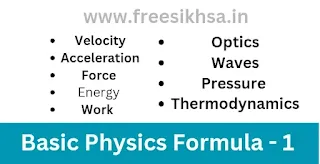Here are some basic physics formulas: Part - I
Velocity:
✅ v = d/t (velocity equals distance over time)
✅ v = u + at (velocity equals initial velocity plus acceleration multiplied by time)
✅ v^2 = u^2 + 2as (velocity squared equals initial velocity squared plus 2 times acceleration times distance)
Acceleration:
✅ a = (v-u)/t (acceleration equals change in velocity over time)
✅ a = F/m (acceleration equals force over mass)
Force:
✅ F = ma (force equals mass times acceleration)
✅ F = G(m1m2)/r^2 (force of gravity equals the gravitational constant times the product of the masses over the distance squared)
Work and Energy:
✅ W = Fd (work equals force times distance)
✅ KE = 1/2 mv^2 (kinetic energy equals one-half mass times velocity squared)
✅ PE = mgh (potential energy equals mass times gravitational acceleration times height)
✅ P = W/t (power equals work done over time)
Pressure:
✅ P = F/A (pressure equals force over area)
✅ P = rho * g * h (pressure equals density times gravity times height)
Waves:
✅ v = f * lambda (wave velocity equals frequency times wavelength)
✅ E = hf (energy of a photon equals Planck's constant times frequency)
Thermodynamics:
✅ Q = mc(delta)T (heat energy equals mass times specific heat capacity times change in temperature)
✅ P * V = n * R * T (ideal gas law - pressure times volume equals number of moles times gas constant times temperature)
Optics: 1
✅ n = c/v (refractive index equals speed of light in vacuum divided by the speed of light in the medium)
✅ m = -i/o (magnification equals image distance divided by object distance)
✅ f = 1/do + 1/di (lens formula - focal length equals one over object distance plus one over image distance)
Thermodynamics:
✅ Q = mcΔT (heat transferred equals the mass of the substance times its specific heat capacity times the change in temperature)
✅ PV = nRT (ideal gas law - pressure times volume equals the number of moles times the gas constant times the absolute temperature)
✅ dS = dQ/T (change in entropy equals the amount of heat transferred divided by the temperature)
Optics: 2
✅ n1sinθ1 = n2sinθ2 (Snell's law - the ratio of the sines of the angles of incidence and refraction is equal to the ratio of the refractive indices of the two media)
✅ f = 1/do + 1/di (lens equation - the focal length of a lens equals the reciprocal of the object distance plus the reciprocal of the image distance)
✅ m = hi/ho = -di/do (magnification - the magnification of an image equals the height of the image divided by the height of the object, which is also equal to the negative of the image distance divided by the object distance)
Waves:
✅ v = fλ (wave velocity equals frequency times wavelength)
✅ A = A0sin(ωt + φ) (simple harmonic motion - the displacement of an object in simple harmonic motion is given by its amplitude times the sine of its angular frequency times time plus its phase angle)
✅ I = P/A (intensity of a wave equals the power it carries divided by the area it spreads over)
These are just a few more basic physics formulas. Physics is a vast and complex subject, and these formulas represent only a small fraction of the many equations used to describe the behavior of the physical world.


